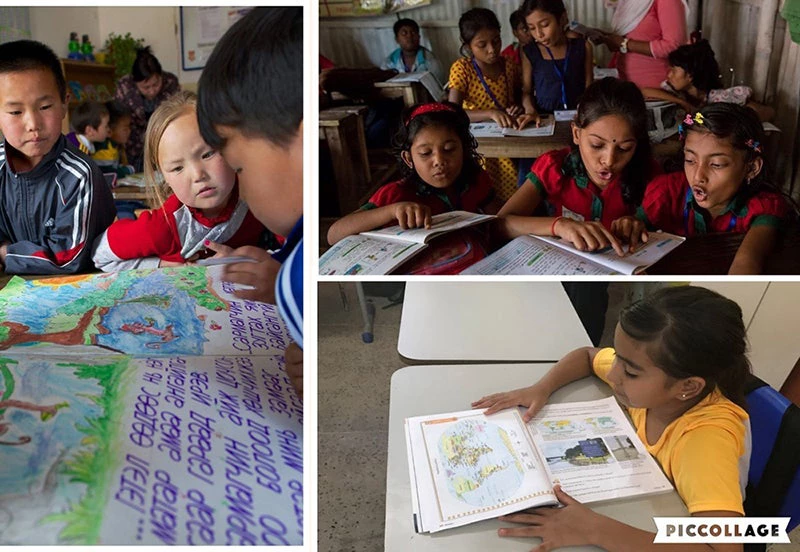
Global trends, including disruptive technology, climate change, and rapidly evolving demographics, continuously redefine the skills that learners need to develop today to become productive workers and engaged citizens tomorrow.
Yet some things do not change: to be ready for the future, all children need to acquire foundational skills, which are the gateway to other skills and subjects. The most fundamental of these skills is literacy.
Before one can read to learn, one must learn to read. Reading with comprehension is arguably the most important skill a child needs to learn in their early school years. Without basic reading proficiency, children will most likely fail to become numerate and are at higher risk of dropping out of school altogether – unlikely to simply “catch-up” over time. Higher levels of behavioral self-regulation are also associated with higher levels of language and literacy.
Despite more students attending primary school than ever before, a shockingly high number of them fail to read by the time they graduate. 53% of children in low- and middle-income countries are unable to read and understand a simple text at age ten — they are known as the “learning poor”. The rate is much higher across Sub-Saharan Africa, where Learning Poverty is a staggering 87%. Despite multiple interventions to improve quality of schooling across countries, at the current rate of improvement, 43% of children will still be Learning Poor by 2030.
The COVID-19 pandemic has exacerbated the learning crisis, especially for the poor. Despite governments investing heavily in distance education during the pandemic, students’ learning will surely decline as a result of school closures. Estimations coming out of Chile paint a dark picture: if face-to-face classes do not restart in the remainder of the school year, students in the country could lose on average, 88% of their expected learning for the year. The impact is largest for students of families from the lowest income quintile, who will lose 95% of the learning they were expected to acquire this year. Worldwide, more than 7 million students are at risk of dropping out of school due to the decline in family income alone. Now, more than ever, all children need to acquire foundational skills like literacy.
How to universalize foundational literacy? While high-income countries like Finland, Hong Kong, Japan, Poland, Russia, and Sweden have learning poverty rates below 2%, lower-middle-income countries like Vietnam have also gone from being far from achieving universal primary a generation ago, to virtually eliminating learning poverty today (Vietnam’s learning poverty rate is 1.1%). What are these countries doing right?
1. Assure political and technical commitment to making all children literate
It starts with governments and education authorities building policies committed to the goal that all children must learn to read and adopting targets to make this a reality for all children by the end of primary school. Assessments – at all levels – must align to these reading targets and monitor progress toward them.
An interesting example is the municipality of Sobral in the state of Ceará, one of the poorest states in Brazil. Reform started by the late 90s in Sobral when political leaders committed to the goal of having every child reading and writing by the end of second grade. Sustained commitment and leadership, alongside the use of assessments, a focused curriculum, empowering school management, and motivating teachers were the most important ingredients of Sobral’s reform. By 2017, Sobral ranked first among all municipalities in the index that measures education quality in Brazil in both primary and lower secondary education.
2. Ensure effective literacy instruction by supporting teachers
Teachers need to be supported to obtain the knowledge and skills necessary to teach reading. In many settings, this can begin with detailed and highly structured teaching guides for literacy instruction (to provide an extra support to teachers who want it). It also means providing specific and practical professional development, which focuses not only on what to teach, but how to teach it. Moreover, the provision of individualized feedback to teachers on an on-going basis has also shown to have positive impacts on student learning. In South Africa for example, specialized reading coaches who monitored teachers and provided ongoing support led to improvements in student reading proficiency double that of one-off mass trainings conducted outside of the classroom.
3. Provide at least one quality, age-appropriate book per child
The more children read, the better they get at reading. Availability of quality, age-appropriate reading materials makes a difference in building the skills necessary for reading fluently. However, in many countries, students simply don’t have materials to read. For example, in 91% of classrooms observed in Madagascar in 2016, none of the pupils had a textbook in hand. Systems that eliminate learning poverty ensure that students have regular and frequent access to a range of engaging reading materials. It starts with the main classroom text, a notebook, and a pen or pencil. Ideally, this means print- and book-rich classrooms, libraries, and homes where the world of books and reading invites the child to explore and grow.
4. Teach students to read first in the language they best speak and understand
A major and underappreciated obstacle to literacy is the mismatch between the language that students speak best and the language of instruction in their schools. Students who receive home language instruction are more likely to attend school, stay in school, and acquire higher levels of learning. This is especially true for girls, and for minorities whose languages are not represented in formal structures.
Moreover, research from contexts as wide ranging as Malawi, Guatemala, the United States (including a meta-analysis comprising 17 studies), has shown that learning to read in one’s mother tongue can help the acquisition of a second language (typically the lingua franca) in later years. On the other hand, for students who lack the oral language abilities in the language being taught, learning to read becomes much more difficult. Removing these language mismatches at a systems level is critical for all students to learn to read, and eventually, read to learn.
5. Foster children’s language abilities and promote the love of books and reading
Developing oral language skills lead to better reading proficiency and positive attitudes towards books and reading. According to psychology professor Dan Willingham, author of the book Raising Kids Who Read, there are many strategies that parents and teachers can follow to increase children’s enthusiasm and motivation towards reading. Children develop reading skills while they read for pleasure as much as when they read academic texts. Families can link reading to positive activities, such as visiting a library as a family or having “reading time” at home.
These five interventions have shown to accelerate progress towards reading and raise overall education quality in relatively short periods of time. They make up the World Bank’s forthcoming new “Literacy Policy Package” (LPP). Broader reforms are also needed to maintain progress and expand the improvements made in reading to other areas of learning. But we believe it can be done, and more importantly, that it must be done. In 2019, to galvanize action and align all actors around fighting learning poverty, the World Bank launched a Global Learning Target: to reduce by at least half the global Learning Poverty rate by 2030.
The science of reading lays out a clear path for all students to have their best chance to become capable, engaged, lifelong readers. The LPP encapsulates this evidence and allows countries to “move the needle” in the direction of universal basic literacy. Ending learning poverty and getting every child reading is not an easy task to achieve, especially in the face of a global pandemic that is further jeopardizing learning outcomes.
Now, more than ever, targeted efforts in eliminating illiteracy are critical for the millions of children and their families across the world who deserve and aspire to expanded education opportunities in life.





Join the Conversation